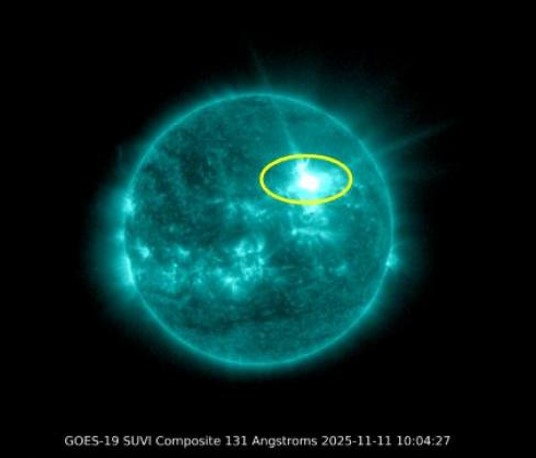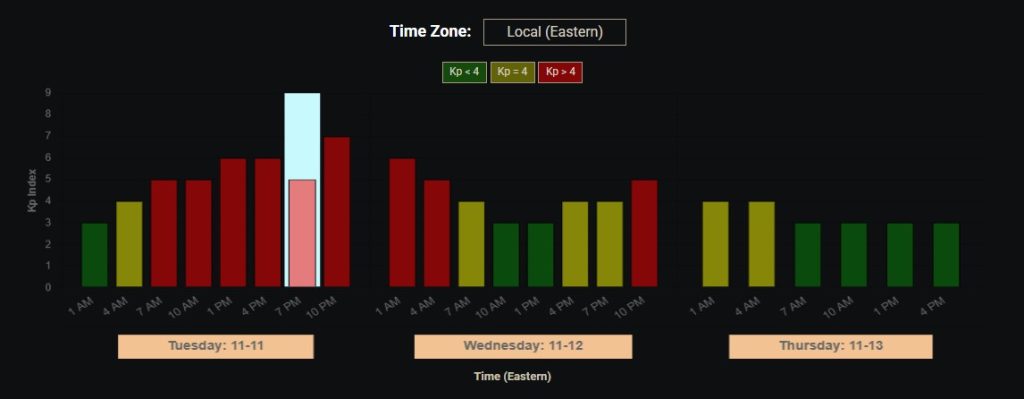
ASHEBORO N.C. (ACME NEWS) — Space Weather Forecasters at the Space Weather Prediction Center (SWPC) say a series of powerful solar eruptions are heading toward Earth, and the resulting geomagnetic storm could make the Northern Lights visible as far south as North Carolina over the next few nights.
The Space Weather Prediction Center (SWPC), part of NOAA, has issued Geomagnetic Storm Watches covering November 11–13, with the potential for G4 (Severe) activity on Tuesday, November 12. A G2 (Moderate) storm is possible tonight, followed by G3 (Strong) conditions on Wednesday.
A Burst of Solar Energy

The storm watches follow multiple coronal mass ejections (CMEs)—massive bursts of solar plasma and magnetic fields—launched from the Sun between November 9 and 11. The most recent and most energetic CME was tied to an X5.1-class solar flare, which peaked at 5:04 a.m. EST on November 11.
NOAA says this was one of the most powerful flares observed in the current solar cycle. It caused shortwave radio blackouts on the sunlit side of Earth and triggered a moderate S2 solar radiation storm, which continues to affect the near-Earth environment.
The newest CME is expected to arrive Tuesday evening, with strong geomagnetic effects likely to continue into Wednesday. “There is a potential for G4 levels upon CME arrival and as the CME passage progresses,” SWPC forecasters said.
What It Means for the Carolinas
If the storm reaches severe levels, skywatchers across the northern United States—and possibly as far south as the Carolinas —could catch a glimpse of the aurora borealis, or Northern Lights.
Forecasts from the University of Alaska Fairbanks show activity levels reaching Kp7, a threshold high enough to make auroras visible near the northern horizon in North Carolina if skies are clear. The best viewing window is expected between 10 p.m. and 1 a.m. Eastern Time tonight and again Tuesday night.
Local conditions such as cloud cover and light pollution will play a major role in visibility. While the aurora may not be bright enough for the naked eye in Randolph County, long-exposure photos could reveal faint green or red glows near the horizon.

Behind the Glow
The aurora occurs when charged particles from the Sun collide with gases in Earth’s upper atmosphere, causing those atoms to emit light—much like a neon sign. These particles follow Earth’s magnetic field lines, concentrating near the poles where the atmosphere funnels them downward.
The strength of geomagnetic activity is measured on a Kp index ranging from 0 (quiet) to 9 (extreme). Any value above Kp5 indicates a geomagnetic storm, and readings near Kp7 are considered high enough to expand the auroral oval into the mid-latitudes.
Stay Updated on Space-Weather
The SWPC warns that geomagnetic storms of this level can cause minor impacts to power systems, satellite operations, and radio communications, though these effects are typically manageable. Forecasters will monitor real-time solar wind data as the CME approaches Earth, which will provide clearer information about the storm’s intensity and timing.
Residents can track updates and live forecasts at:
— NOAA Space Weather Prediction Center (swpc.noaa.gov)
—University of Alaska Fairbanks – Aurora Forecast (gi.alaska.edu/monitors/aurora-forecast)
###

